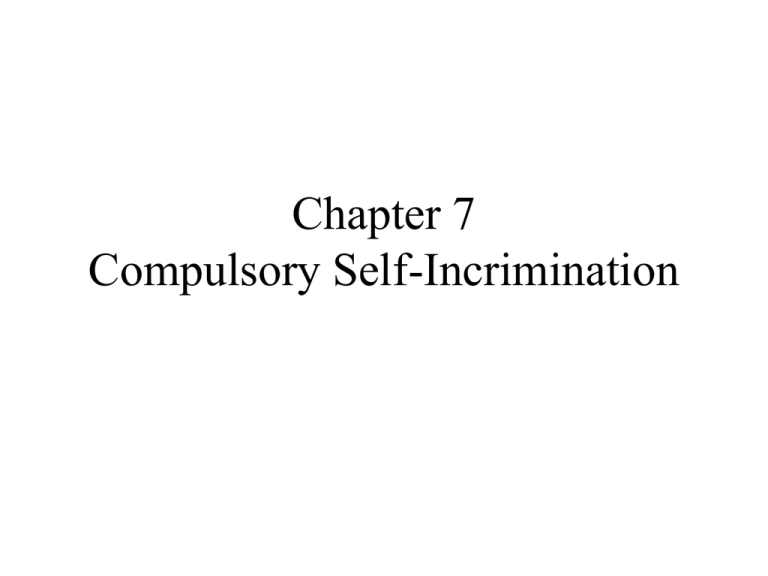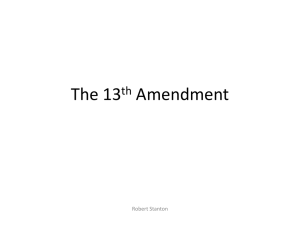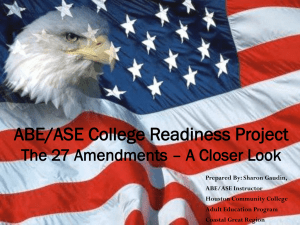Chapter 7 Compulsory Self
advertisement

Chapter 7 Compulsory Self-Incrimination Self-incriminating evidence: Two categories 1. Testimonial evidence – communication of thoughts or information in response to official questions or interrogations. 2. Physical evidence – all evidence other than testimonial. Can be either appearance and bodily evidence • Appearance evidence – evidence obtained from body characteristics that suspect routinely exposes to public. • Bodily evidence – physical evidence obtained from body by 1) searching parts not normally exposed to public, 2) seizing biological materials, or 3) seizing foreign substances on or inside body Note: Compulsion to furnish selfincriminating physical evidence is regulated by Fourth Amendment Fifth Amendment Protection Against Testimonial SelfIncrimination • The Fifth Amendment privilege against testimonial self-incrimination is violated whenever government compels disclosure of testimonial evidence that could later be used against the person in a criminal proceeding. There are two levels of Fifth Amendment protection • Absolute right to remain silent during custodial interrogation and at their criminal trial. • In all other situation, citizens may be compelled to appear and testify, but are privileged to refuse to answer specific questions if the answer might tend to incriminate them. Prerequisites for Application of Fifth Amendment • Fifth Amendment is violated when citizen is compelled to furnish self-incriminating testimony. Three prerequisites: 1) Testimonial-Communication of person’s thoughts, beliefs, or knowledge. May be oral written, or inferred from person’s conduct. Note: It does not include person’s handwriting or voice characteristics, which are a form of physical evidence. Compelled physical evidence does not violate Fifth Amendment Prerequisites of Fifth Amendment, cont’d. 2) Compulsion – Occurs when government demands disclosure of information that is backed by threat of sanction 3) Self-Incrimination – To be selfincriminating, compelled answer must expose person to risk of criminal prosecution. Fifth Amendment Prerequisites, cont’d A. Fifth Amendment does not apply to responses to routine booking questions. B. Persons who have already been tried for crime about which they are questioned may not invoke Fifth Amendment because of double jeopardy. C. Persons who have been granted immunity may not invoke the 5th. Immunity • Absolute Immunity- exempts from prosecution for crimes revealed during compelled testimony • Use Immunity – does not exempt from prosecution; it bars the government from using any information revealed during compelled testimony, including evidence derived from it. Immunity, cont’d. • Use immunity (including derivative) is adequate to satisfy 5th Amendment requirements for compelling testimony. • Only prosecutor has authority to grant immunity. If police promise immunity to elicit information from a suspect, the suspect’s statement will be considered involuntary and will be suppressed. • Class discussion questions. Invoking Fifth Amendment • Criminal defendants have Fifth Amendment right to remain silent at their criminal trial. • Witnesses other than criminal defendants do not have right to remain silent. They must take the witness stand and may invoke privilege against self-incrimination only if they are asked questions that call for an incriminating response. Waiving the Privilege • Criminal defendants – by voluntarily taking the witness stand and testifying on their own behalf. • Witnesses other than criminal defendants – when they voluntarily answer incriminating questions without invoking the privilege. Protection from Adverse Consequences from Exercising Privilege Against Self-Incrimination • When defendant chooses not to testify, judges and prosecutors are prohibited from making any direct adverse comment during trial about defendant’s decision not to testify. • Witnesses other than criminal defendants are protected against adverse consequences only when consequences are imposed as penalty for exercising 5th Amendment rights • When litigant in civil case invokes 5th Amendment and refuses to answer relevant questions, judge may instruct jury to find in favor of opposing party on the matter the witness has refused to disclose. Self-Reporting Laws and Fifth Amendment • Citizens involved in criminal activity are not excused from complying with reporting laws, such as IRS laws, which serve a legitimate regulatory purpose. • Citizens may refuse to comply with government reporting laws that serve no regulatory purpose other than forcing them to disclose their criminal activity. Fourth Amendment Protection Against Bodily SelfIncrimination • Fifth Amendment protects only testimonial evidence. Evidence derived from suspect’s body rather than mind is physical evidence and thus, not protected by Fifth Amendment • Schmerber v California – blood tests did not violate 5th Amendment. Fourth Amendment & Bodily Self-Incrimination, cont’d • Pennsylvania v Muniz – Miranda warnings are necessary only when the police seek to elicit self-incriminating testimony from suspect. Warnings not required before compelling suspects to cooperate in generating self-incriminating physical evidence, e.g. fingerprinting, photograph, lineup, handwriting/voice samples, urine, blood, field sobriety tests, etc. Fourth Amendment & Bodily Self-Incrimination, cont’d • Compelled production of physical evidence is regulated by Fourth Amendment. The Fourth Amendment protects three discrete interests citizens have: 1) Freedom of movement, 2) Bodily privacy, and 3) Bodily integrity Fourth Amendment, cont’d. • Physical evidence taken from suspect’s body is divided into two categories: 1) Appearance evidence, and 2) bodily evidence. 1) Appearance Evidence: evidence taken from suspect’s body without invading his privacy, penetrating body surface, or seizing biological or foreign materials. • 4th Amendment interest invaded: freedom of movement Fourth Amendment, cont’d. • Appearance evidence includes evidence obtained from the following procedures: lineups, showups, photographs, fingerprints, body measurements, voice and handwriting exemplars, and field sobriety tests • Compelled production of appearance evidence is permissible whenever police have constitutional grounds to seize and detain suspect long enough to perform the procedure. • All appearance procedures are permissible when police have probable cause for arrest • Appearance evidence procedure that can be completed quickly in the field may be performed if police have reasonable suspicion for Terry stop. However, may not transfer suspect to station under Terry. 2) Bodily evidence: Evidence derived from a suspect’s body by: 1) searching areas not normally exposed to public, 2) penetrating body surface, or 3) removing biological or foreign substances. Includes following procedures: 1) removing residue from body surface, 2) taking x-rays, 3) taking body tissue and fluids (e.g. blood, semen, etc.) 4) performing strip searches and body cavity searches, and 5) reaching into suspect’s mouth or pumping stomach to recover evidence. • Unlike appearance evidence, which involves no intrusion beyond seizure of person, procedures involving bodily evidence either expose matters in which suspect maintains a reasonable expectation of privacy, resulting in a Fourth Amendment search, or involve seizure of tangible items from a person, triggering Fourth Amendment seizure protection. Revisit Schmerber v California • No Fifth Amendment issue, because extracting blood does not involve testimony. • Fourth Amendment issue: Compelled intrusion into Schmerber’s body to obtain blood sample is a seizure of his person and a search for evidence and is therefore a 4th Amendment issue. Schmerber, cont. • Searches involving intrusions beyond body surface require search warrant, unless the bodily evidence sought is of type likely to deteriorate rapidly. • Court held police complied with Fourth Amendment in taking blood: they had probable cause; because blood-alcohol levels metabolize rapidly, police faced with exigent circumstance that did not allow time for search warrant; procedure was performed in reasonable manner by trained professional. Bodily Evidence, cont. • Four factors must be satisfied to determine if procedure was performed in a reasonable manner: 1) Government’s need for evidence must outweigh suspect’s interest in privacy or bodily integrity that procedure will invade, Clear indication that procedure will produce needed evidence, Police must obtain search warrant before performing procedure – unless immediate danger evidence will be destroyed, Procedure to recover must be reasonable and performed in reasonable manner. 2) 3) 4) • Justification for procedure: Government’s burden to demonstrate need for evidence increases as the procedure becomes more invasive. Thus, stronger showing of need is necessary to compel drawing blood than for procedures that swab under fingernails or pluck stand of hair. • Manner: Procedures involving bodily evidence must be performed in a reasonable manner, with due regard for privacy and health concerns of suspect. Qualified personnel must generally be used for procedures that involve intrusions below the body’s surface other than emergency seizure of objects from suspect’s mouth • Need for warrant: Unless emergency threatens destruction of evidence, courts require search warrant is usually required for procedures that : 1) involves saliva, urine, semen, pubic hair, or other bodily fluids; 2) penetrates body’ surface; 3) requires examination of rectal or genital cavities; 4) involves physical pain or severe discomfort; 5) is dangerous to health; or 6) is degrading or humilating 1) Testing for intoxication: warrants are not required before drawing blood to test for intoxication. 2) Swabbing for residue: no warrant required for residue left on skin, since it can deteriorate rapidly. 3) Retrieving swallowed evidence: If police have probable cause that suspect placed evidence in mouth, they may use reasonable force to prevent him from swallowing – includes reaching into mouth. Courts are split on use of chokeholds. 4) Strip searches: reasonable suspicion 5) Body cavity searches: probable cause









